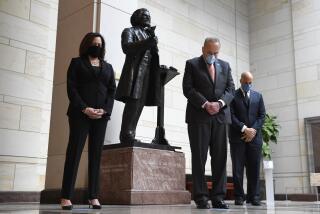Fuel prices squeeze cities
DENVER — Squeezed by soaring energy prices, governments around the nation are reacting just like consumers -- changing basic routines, and scrimping and saving in order to get by.
The El Paso County Sheriff’s Department in southeastern Colorado has ended car patrols of its 2,000-square-mile jurisdiction. One Ohio sheriff is putting his deputies into golf carts. Stillwater, Okla., has stopped mowing the grass on nearly half of its parkland. Cleveland is remapping its trash pickup routes to cut costs.
“I know it’s a step backwards,” said El Paso County Sheriff Terry Maketa, whose deputies will now respond only to calls for help. “But when the dollars aren’t there, they aren’t there.”
High energy costs have taken a toll on government budgets already strained by the housing collapse. “They have a much more direct role in affecting consumer confidence, which can affect sales tax revenue, which accounts for one-third of state revenues,” said Arturo Perez, an analyst at the National Conference of State Legislatures.
That has helped push nearly half the states into budget deficits this year; 24 are cutting services to close the gaps, Perez said. In California, lawmakers are struggling to close a $15.2-billion deficit.
Municipal governments, which rely on state aid plus local tax money, are also feeling the pinch.
School buses are major gas guzzlers, and several districts are cutting back routes. In suburban Seattle, the Northshore School District has cut eight bus routes, requiring some students to walk farther to get to their stops. Children will no longer be able to use school buses to travel to gifted programs at far-off schools.
Parents are not happy. “It took some getting used to, because people like having their bus stop really close to their home,” spokeswoman Susan Stoltzfus said. “But school buses generally get six miles to a gallon.”
In St. Joseph County in Indiana, the library system is facing major cuts and has decided to park its Readmobile for most of the summer. “It’s very frustrating. . . . We just can’t do the regular runs like we did in the past,” spokesman David Hanna said.
Several cities, counties and states are either shifting to a four-day workweek or considering it. Utah announced that starting in August, state offices will be open Monday through Thursday. Officials expect to save at least $3 million in energy costs by going dark on Fridays.
In Lubbock County, Texas, commissioners are trying to figure out a way to shift to a four-day week but fear the change could deprive taxpayers of services.
“We’re trying to save all we can,” Commissioner Mark Heinrich said. “If you do something, you’re not going to please everyone.”
Government officials have struggled this year over how to save money on energy without cutting essential services. According to a recent survey by the National Conference of Mayors, a quarter of mayors have cut services to make up for increased fuel costs.
Some cities are taking innovative approaches. In Oklahoma, Stillwater has designated “natural areas” of parkland where grass will be allowed to grow unimpeded. Starting this month, workers are mowing less than half the acreage they were mowing last year.
“There’s been a lot of building here recently,” spokeswoman Sherry Fletcher said. “We don’t have as many natural areas as we should.”
In Texas, fuel costs account for 10% of the capital city’s projected $20-million deficit. Austin is requiring all employees who drive public vehicles to attend seminars on proper maintenance schedules and other ways to reduce fuel costs. It’s also converting its fleet of public vehicles, buying for the Police Department 118 Crown Victorias that run on an ethanol-gasoline blend, said Matt Watson, policy director for the mayor’s office.
Denver has turned up thermostats in city buildings 4 degrees and allowed its workers to shed jackets and ties to compensate. “What you’re getting is a more casual, comfortable lifestyle that saves money and puts less CO2 in the atmosphere -- what’s not to like?” Mayor John Hickenlooper said.
Los Angeles Mayor Antonio Villaraigosa has directed city departments to cut fuel usage and reduce their fleets by 10%. The city is finishing a new system that will track gas usage in each of its 9,000 cars, said Tony DeClue, assistant general manager of the General Services Department.
“We don’t expect to have any reductions in services due to the fuel crisis,” he said.
Cleveland was already in the midst of a major efficiency campaign when officials found that they were going to be several million dollars over budget. They’ve cut 1,000 cars from the city fleet and used computer analysis to rearrange trash pickup routes.
“What’s smacked us in the face is the same thing that’s hit everyone -- gas prices,” said Chief Operating Officer Darnell Brown, who has asked department heads to shave 10% from their fuel costs.
Public safety -- police, fire and ambulance services -- account for nearly half the city’s expenses, Brown said, and that area is tough to cut.
The burden of fuel costs has fallen disproportionately on law enforcement agencies. “If fuel prices keep going up, it’s going to have a devastating impact on our ability to function,” said Hubert Williams, president of the Police Foundation in Washington.
Governments are in a bind: “You can’t increase taxes and you can’t raise revenues, but you can’t cut back on policing,” he said.
Departments across the country have tried to come up with ways to cut fuel use. In Fairfield County, Ohio, the Sheriff’s Department has bought two golf carts to replace cruisers patrolling small towns.
Some are shifting to two-officer patrol cars. In Newberry, S.C., Police Chief Jackie Swindler has ordered his officers to spend more time on foot patrol. Increased foot patrols, he said, provide better community policing and are preferable to the department’s response during the oil shock of the 1970s: He recalls wrestling with a propane-powered squad car that was so small he couldn’t fit anyone into the rear seat.
In sprawling El Paso County, which includes Colorado Springs, Sheriff Maketa doesn’t have the option of having his deputies walk their beats. His agency’s fuel costs were $160,000 in 2003. This year they’re $700,000, and he’s expecting them to jump more next year.
Maketa initially switched to two deputies per car. Then he forbade idling vehicles. Neither led to big enough savings. This month, he decided to end all patrols to save money, though he predicts his deputies will catch fewer drunken drivers and fewer suspects with outstanding warrants. The department will reassess the end of patrols if it finds there is a serious effect on public safety.
“This decision goes against everything I believe in,” Maketa said. “I believe in preventing crime. I believe in being proactive.”
He said he didn’t know of another agency that had taken such a dramatic step. But based on his discussions with other law officers, he expects company.
“If fuel continues on the pattern we’ve seen the last two years,” he said, “you’ll see a lot of people making a similar decision.”
--
More to Read
Sign up for Essential California
The most important California stories and recommendations in your inbox every morning.
You may occasionally receive promotional content from the Los Angeles Times.










